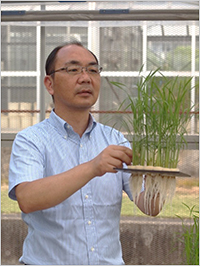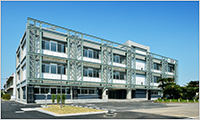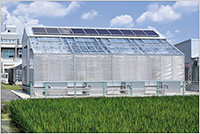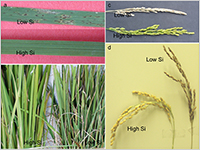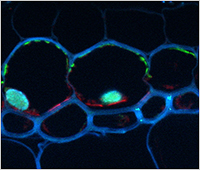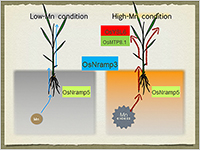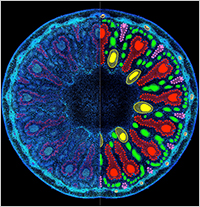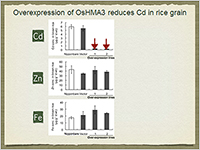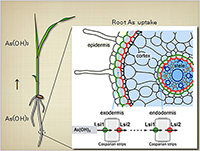Enlarge Image Phytotron for genetically modified (GM) plants
Enlarge Image Beneficial effect of silicon on plant. Silicon is able to protect the plants from various stresses such as pathogen, insect damage and water loss.
Enlarge Image Silicon transporters for uptake in rice. Silicon uptake is mediated by Lsi1 (green) and Lsi2 (red), localized at the distal and proximal side of both root exodermis and endodermis.
Enlarge Image Multiple mechanisms of Al tolerance in rice. High Al tolerance in rice is achieved by a transcription factor, ART1, which regulates at least 30 genes implicated in Al tolerance.
Enlarge Image Strategy of rice to overcome manganese changes in the environment.
Enlarge Image Cross section of rice node, a hub for distribution of mineral element.
Enlarge Image Effect of over-expression of OsHMA3 gene on Cd accumulation in rice grain.
Enlarge Image Pathway of arsenite in rice. Arsenite uptake is mediated by two silicon transporters; Lsi1 and Lsi2.
Enlarge Image
Plants feel stress!
Frontiers in plant mineral stress tolerance and how nutrients and toxins are absorbed by rice and other plants
Professor Jian Feng Ma
Head of the Plant Stress Physiology Group, Institute of Plant Science and Resources, Okayama University, Japan.
Professor Jian Feng Ma describes his research on the identification of critical transport mechanisms governing the absorption and distribution of mineral nutrients and toxins by rice and other plants. These findings are important for the efficient and safe production of food crops for sustaining human life on Earth.
Plants feel stress! But not the type that inflicts the lives of humans in the hustle and bustle of modern life. “Plants require 14 mineral elements to grow and survive,” says Professor Jian Feng Ma, head of the Group of Plant Stress Physiology of the Institute of Plant Science and Resources, Okayama University. “Plant stress is induced by a deficiency of any of these minerals, absorption of poisonous elements such as arsenic and cadmium, and adverse weather conditions. My research is focused on determining the mechanisms that govern the absorption of minerals by plants. I work mainly on barley and rice.” Ma adds that plants also absorb toxic elements, such as cadmium and arsenic as well, so the results of his research are important for monitoring the safety of agricultural products.
Japan has an excellent international reputation for research on plant stress physiology and the Institute of Plant Science and Resources, Okayama University is renowned for the high quality of its research with recent reports by independent assessment agencies showing the institute to be ranked 6th in Japan in this field of research. “We are a relatively small institute, with only 35 or so research staff,” says Ma. “So we are pleased to be ranked so close to huge Japanese research organizations such as RIKEN. This high assessment reflects the excellent research conducted by our predecessors at this institute. Also we insist on whole plant physiology at the molecular level, and whole plant genome analysis. We grow proper plants.”
Professor Ma’s research is focused on the determination of the nature of ‘transporters’ that are responsible for the absorption of minerals by plants. Specific examples of include determination of transporters for the absorption and distribution of silicon, iron, manganese, cadmium, and arsenic. “Our findings for silicon showed the importance of this mineral element for the growth of a healthy plant,” explains Ma. “The presence of silicon in plants prevents disease and also makes plants resilient towards adverse weather such as strong winds. There are still many challenging mysteries in the world of plant stress.”
Research highlights
Silicon transporters
The accumulation of silicon in plants is beneficial for their growth by enabling them to overcome biotic and abiotic stress. In 2006 and 2007 Ma and colleagues identified two different transporters for silicon in rice plants.
J.F. Ma et al, A silicon transporter in rice, Nature 440, 688-691 (2006).
J.F. Ma et al, An efflux transporter of silicon in rice, Nature 448: 209-211 (2007)
Aluminum toxicity stress
Aluminum is toxic to plants and affects the production of crops in acidic soils. Ma and his colleagues have identified the genes involved in aluminum tolerance and the regulation mechanism in plants.
N. Yamaji et al, A Zn-finger transcription factor ART1 regulates multiple genes implicated in aluminum tolerance in rice, Plant Cell, 21, 3339-3349, (2009).
Molecular mechanisms of environmental responses and manganese absorption
Rice is a robust plant able to adjust to its environment. For example, manganese is a nutrient for plants but when present in excess it exhibits phytotoxicity, which is harmful for plant growth. But rice is able to grow in a wide range of Mn concentration by regulating the uptake, distribution, and detoxification. Ma and colleagues have identified genes that govern this control and detoxification of Mn in rice plants.
N. Yamaji et al, A node-based switch for preferential distribution of manganese in rice, Nature Communications 4, 2442, (2013).
Transporters of arsenic and cadmium in rice
Excess cadmium in plants poses dangers for food safety. Ma and colleagues have clarified the molecular mechanisms of transporters governing Cd accumulation in rice and barley.
Arsenic is poisonous with an estimated 40 million people suffering from toxicity worldwide. Notably, rice is a major source of arsenic poisoning in the food chain. Ma and colleagues have defined transporters responsible for absorption and distribution of As by rice in paddy fields.
J. F. Ma et al, Transporters of arsenite in rice and their role in arsenic accumulation in rice grain. Proceedings of the National Academy of Sciences (PNAS), 105, 9931-9935, (2008).
D. Ueno et al, Gene limiting cadmium accumulation in rice, Proceedings of the National Academy of Sciences (PNAS), 107, 16500-16505, (2010).
Recent publications
1.N. Yamaji et al, Orchestration of three transporters and distinct vascular structures in node for inter-vascular transfer of silicon in rice. Proc Natl Acad Sci USA doi/10.1073/pnas.1508987112 (2015)
2.W. Y. Song et al, A rice ABC transporter, OsABCC1, reduces arsenic accumulation in the grain. Proc Natl Acad Sci USA 111: 15699-15704 (2014)
3.J. F. Ma and N. Yamaji, A cooperative system of silicon transport in plants. Trends Plant Sci. doi.org/10.1016/j.tplants.2015.04.007 (2015)
4. M. Ashikari and J. F. Ma, Exploring the power of plants to overcome environmental stresses. Rice, 8, 10, (2015). DOI 10.1186/s12284-014-0037-y
Further information
1. Institute of Plant Science and Resources, Okayama University, website:
http://www.rib.okayama-u.ac.jp/plant.stress/index.html
2. YouTube videos about research at the Institute of Plant Science and Resources, Okayama University, Japan.
https://www.youtube.com/watch?v=-yNuldmwyuI
https://www.youtube.com/watch?v=tlFm-UIHzeY
3. University of Okayama e-Bulletin Research Vol.4 Okayama Travelogue:
“Okayama University Institute of Plant Science and Resources in Kurashiki: The oldest agricultural research institute in Japan”
http://www.okayama-u.ac.jp/user/kouhou/ebulletin/topics/vol4/travelogue.html

